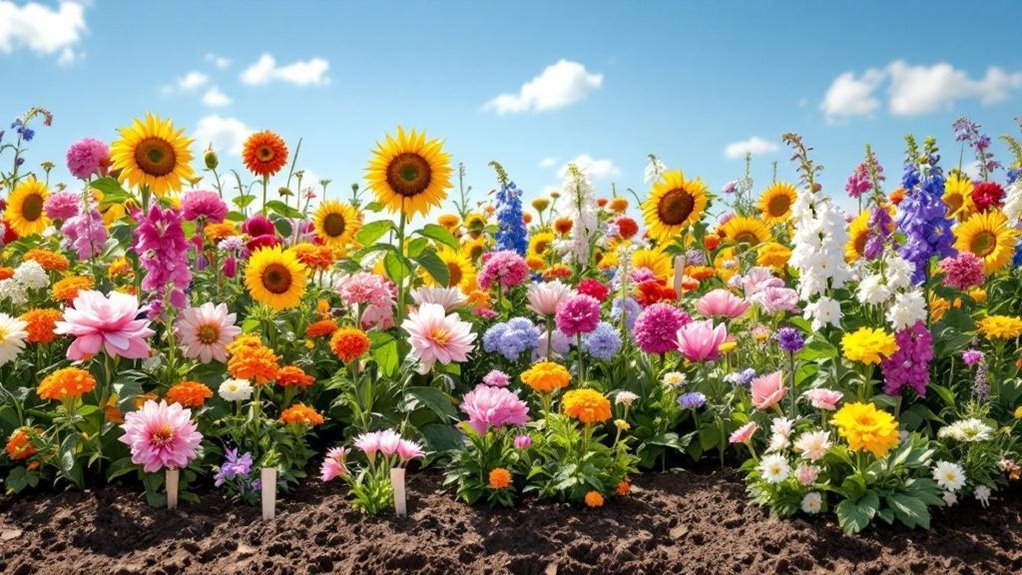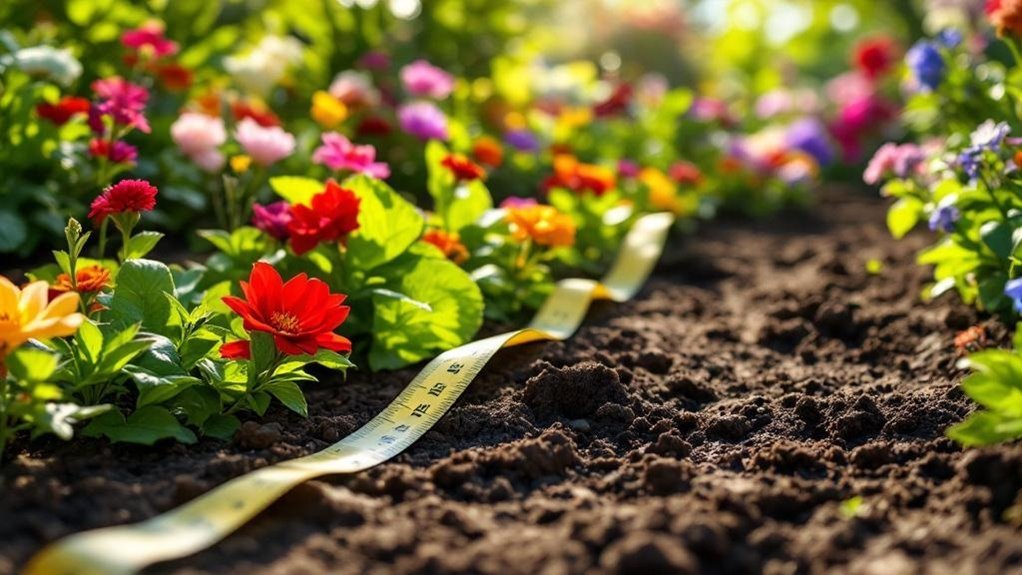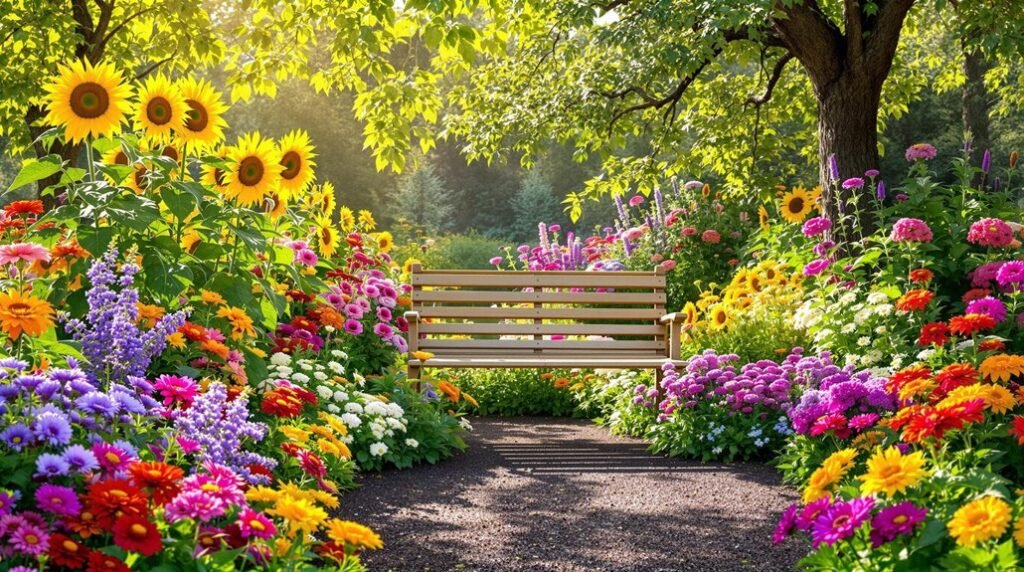Think of your cut flower garden as a living palette, where each bloom adds a brushstroke of color and life. You’ll want to carefully plan every detail—from choosing the perfect sunny spot to selecting flowers that bloom in succession—so your garden stays vibrant all season long. But before you start planting, consider how design and timing can make all the difference in creating a truly stunning and sustainable floral display.
Selecting the Ideal Location for Your Cut Flower Garden
Choosing the right spot for your cut flower garden is crucial for vibrant blooms.
First, pick a location that gets 6-8 hours of direct sunlight daily since most cut flowers need full sun to thrive.
Choose a spot with 6-8 hours of direct sunlight for your cut flowers to flourish.
Check that the area has well-drained soil free from large tree roots, which compete for water and nutrients. Conduct a soil test to assess nutrient levels and pH, so you can amend the soil accordingly for healthy growth.
When planting flower seeds, avoid overcrowding by spacing them 6-8 inches apart to give each plant room to flourish.
Also, consider wind protection by choosing sheltered areas or adding barriers, especially for taller flowers, to prevent damage from strong winds and heavy rain.
These steps set your garden up for success.
Designing an Effective Garden Layout
Once you’ve selected the perfect spot for your cut flower garden, the next step is designing a layout that maximizes both beauty and ease of care.
Start by clearly defining garden boundaries with edging or stones to give your space structure. Group plants with similar water and sunlight needs to simplify maintenance and guarantee efficient use of resources.
Plan pathways that allow easy access for harvesting and upkeep. Use graph paper or digital tools to visualize your garden layout, considering color schemes and varying flower heights to create strong visual interest.
Arrange taller plants at the back and shorter ones upfront to enhance the overall look.
- Define garden boundaries and pathways for easy maintenance
- Group plants by needs to optimize resources
- Balance flower heights and color schemes for visual appeal
Choosing Flower Varieties for Continuous Blooms

To keep your cut flower garden vibrant all season, you’ll want to select a mix of annuals and perennials that bloom at different times. This approach guarantees continuous blooms, from early daffodils to late asters.
Group flower varieties with similar needs—sunflowers thrive in full sun, while foxgloves prefer shade—to simplify care and boost bloom longevity. Incorporate focal flowers like peonies, fillers such as baby’s breath, and airy touches like Queen Anne’s lace for dynamic flower arrangements.
Use succession planting by staggering sowing dates of varieties like zinnias and cosmos, extending your garden’s color and cut flower supply.
Finally, choose flowers with good vase life, like dahlias and sunflowers, to enjoy your blooms longer and enhance your garden design’s effectiveness.
Planning Seed Starting and Planting Schedules
Because timing is crucial for healthy seedlings and abundant blooms, you should determine your area’s average last frost date before starting seeds indoors or planting outside.
Use seed packet instructions to find the best timing for seed starting, usually 6 to 8 weeks before the last frost dates. Then, create a customized planting schedule by counting backward from your safe outdoor planting date.
To stay organized, consider these tips:
- Use a garden planner to track dates for seed starting, transplanting seedlings, and direct sowing.
- Keep a master to-do list of gardening activities by month to guarantee nothing is missed.
- Regularly update your planting schedule for accurate tracking and best timing.
This approach helps you manage your planting schedule effectively for a thriving cut flower garden.
Space Calculation and Plant Placement Strategies

Although planning your cut flower garden’s layout might seem intimidating, calculating proper spacing and strategically placing plants will boost growth and ease maintenance.
Begin your flower garden design by using graph paper or digital tools to draft a scaled garden layout, marking seedling quantities and planting spots. For space calculation, place each seed 6-8 inches apart with 12-15 inches between rows, ensuring healthy growth and accessibility.
Consider plant height by positioning taller varieties at the back of garden beds for visibility and support. Group plants with similar water needs together to simplify maintenance and promote thriving growth.
Regularly review and adjust your plant placement based on past results to optimize space and productivity in your growing cut flowers journey.
Enhancing Your Garden With Pollinator-Friendly Practices
Careful plant placement not only optimizes growth but also creates an inviting environment for pollinators.
In your cut flower garden, focus on selecting native plants and single-petal flower varieties to attract beneficial insects like bees and butterflies. Including flower varieties with staggered bloom times guarantees a continuous food source throughout the season, supporting pollinator health.
Avoid pesticides and choose organic pest control to protect these essential creatures. You can also enhance habitat by leaving parts of your garden wild and installing bee hotels or butterfly houses.
Gardening tips to boost pollinators in your garden:
- Plant diverse native flowers with staggered bloom times
- Use organic pest control methods exclusively
- Provide shelter like wild patches and pollinator-friendly structures
These steps keep your garden thriving and pollinator-friendly.
Frequently Asked Questions
How to Layout a Cut Flower Garden?
You’ll want to define clear garden boundaries and arrange plants by color and height. Group flowers by sunlight and water needs, plan pathways for easy access, and stagger planting times to keep blooms continuous throughout the season.
How to Design a Flower Garden Layout?
You’ll want to define your garden’s boundaries, plan your layout on paper, group plants by sunlight and water needs, create accessible pathways, and mix flower types by color or bloom time for visual appeal and easy maintenance.
What Is the #1 Most Sold Cut Flower?
You might guess daisies or tulips, but roses hold the crown as the most sold cut flower worldwide. Their timeless beauty and fragrance keep buyers coming back, especially for special occasions like weddings and Valentine’s Day.
What Is the Spacing for Cut Flower Garden Rows?
You should space your cut flower garden rows about 12-15 inches apart. This spacing lets you move easily for maintenance and harvesting while ensuring your flowers get enough room to grow strong and healthy.
Final Thoughts
Now that you’ve planned your cut flower garden with the right location, layout, and bloom schedule, are you ready to watch your vibrant blooms flourish? By grouping plants based on their needs and welcoming pollinators, you’re creating more than just a garden—you’re cultivating a thriving, colorful space full of life. With thoughtful design and care, your cut flower garden will bring beauty and joy all season long. Isn’t that a garden worth growing?
